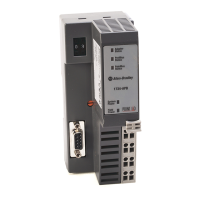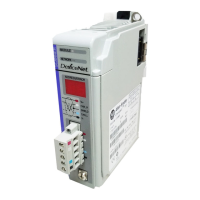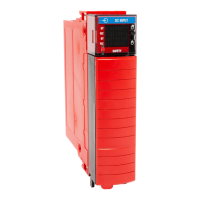Publication 1757-RM810A-EN-P - May 2002
Functional Blocks 3-49
RATIOBIAS
Description Accepts a ratio value input (RT) and an input value (X1) to provide a calculated output based on the ratio of the input
variables plus a fixed and/or a floating bias. The input value must come from another function block. In the Cascade
mode, the ratio input value must come from another function block; but, in the Automatic (Auto) Mode, an operator or
user program can set the ratio value.
Function Lets you implement a form of ratio control by using this block between two PID blocks. In this case, the output from
one PID block is used as the X1 input to the RATIOBIAS block and the output from the RATIOBIAS block is used as the
SP input to the second PID block.
Timeout
Monitoring
In cascade mode, this block performs timeout monitoring on both inputs (X1 and RT). If either input value is not
updated within a predefined time, this block invokes the following timeout processing.
• If RT times out, block
– Sets the input timeout flag (TMOUTFL).
– Holds RT at its last good value.
– Sheds to the configured timeout mode (TMOUTMODE).
– Requests the RT primary to initialize.
• If X1 times out, block
– Sets the X1 value to NaN. This causes CV to go to NaN, which results in the initialization of the RT and X1
primaries.
If RT times out and the block sheds to Auto mode, block sets the Cascade Request flag (CASREQFL). When CASREQFL
is set, it means the block is waiting to return to the cascade mode, and will do so as soon as it gets a good X1 value.
This is true only, if the original mode was Cascade and the TMOUTMODE is Auto . If you change the mode, this clears
the CASREQFL and disables the return to cascade operation.
Control
Initialization
Block brings initialization requests from its secondary through BACKCALC. In addition, the secondary may propagate
oneshot initialization requests to this block. However, you can disable the SECINITOPT so the block ignores
initialization requests from the secondary.
If the secondary is requesting initialization, block:
• Initializes its output:
– CV = initialization value from the secondary,
• Calculates an initialization value for the X1 and RT primaries.
– INITVAL [1] = CV - OPBIAS.FIX / RT
– INITVAL [2] = CV – OPBIAS.FIX / INITVAL [1]
• Requests both primaries to initialize:
– INITREQ [1] = ON
– INITREQ [2] = ON
Override
Feedback
Processing
If this block is in a cascade strategy with a downstream Override Selector (OVRDSEL) block, it receives override
feedback data. The data consists of an override status, override feedback value and an override offset flag. The status
indicates if this block is in the selected or unselected strategy. The offset flag only applies to PID type function blocks.
However, you can disable the SECINITOPT so the block ignores override requests from the secondary.
When override status changes from selected to unselected, this block:
• Computes a feedback value for X1 and RT primaries:
– feedback value for X1 = ORFBVAL - OPBIAS.FIX -OPBIAS.FLOAT / RT
– feedback value for RT = ORFBVAL - OPBIAS.FIX - OPBIAS.FLOAT / X1 override feedback value
More on following page
Spare Allen-Bradley Parts

